|
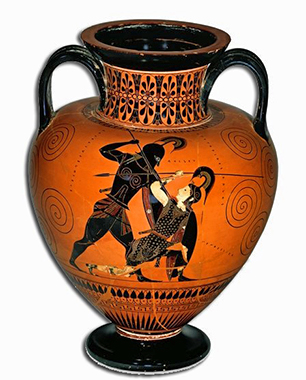
The Civilization
of Ancient Greece
When historians talk about the civilization of the
ancient Greeks, they generally refer to the
time period between 1200 BC and 323 BC.
The year
323 BC marked the death of
 Alexander the Great. Alexander the Great.
|
|
Image Above
Wine jar, made in Athens about 540-530
BC.
British Museum, London.
The scene shows
Achilles at that crucial moment when he killed Amazon
queen Penthesilea, their eyes met, and they fell deeply in love.
Welcome to
ancient Greece.
Timeline of the Ancient Greeks
Historians
divide the years of ancient Greece into the following chapters:
The Dark Age
Very roughly 1200-900 BC
The Archaic
Period
Roughly 900-480 BC
The Classical
Period
(The Golden Age)
Roughly 480-400 BC
The Late
Classical Period
Roughly 400-323 BC
The
Hellenistic Age
323-30 BC
|
Who Lived in the Area Before the Ancient Greeks
Came Along?
Prior to the
ancient Greek civilization, it was the
 Mycenaean civilization that
dominated the area, starting around 1900 BC
or 1600 BC, depending on your source.
Mycenaean civilization that
dominated the area, starting around 1900 BC
or 1600 BC, depending on your source.
The Mycenaean civilization, in turn,
came down into Greece from the north and was in the early days
overshadowed by the
 Minoan civilization that
flourished on the island of Crete.
Minoan civilization that
flourished on the island of Crete.
This is the map:

Map of Mycenaean Greece - 1450 BC
What Came After the Ancient Greek Civilization?
While the
domination of the ancient Greeks faded, the
 ancient Romans gained momentum.
ancient Romans gained momentum.
The switch from Greek glory to Roman
power took place during the last chapter of the history of ancient
Greece, the Hellenistic Age. It
began after the death of Alexander the Great in 323 BC.
Alexander had carried Greek culture to the far corners of his map.
Thus, during the Hellenistic period Greek and foreign elements
merged. Battles, wars, and uprisings were fought for power over all
parts and bits of the former gigantic empire.
In 86 BC, Roman general
 Sulla captured Athens.
Sulla captured Athens.
In 30 BC,
 Cleopatra left Egypt to Rome
via committing suicide.
Cleopatra left Egypt to Rome
via committing suicide.
In 29 BC,
 Octavian made Egypt a Roman
province.
Octavian made Egypt a Roman
province.
In 27 BC, the
 Roman Empire was established.
Roman Empire was established.
Greek or Hellenic, Greece or Hellas — Terminology
If you like Greek mythology, you like
Hellen.
Hellen (male) had three sons � Aeolus,
Dorus, and Xuthus. Xuthus, in turn, had two sons � Ion and Achaeus.
This made Hellen the
ancestor of all Greeks � the Aeolians,
 Dorians, Dorians,
 Ionians,
and Achaeans. Ionians,
and Achaeans.
Thus the Greeks are the Hellenes. And
when you use the term Hellas, you refer to mainland Greece.
And here is a Greece / Hellas stamp from 1978:
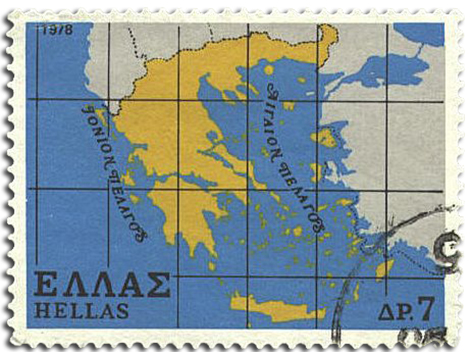
Greek Stamp 1978 — Greece / Hellas
Dan's Stamps
Mythology aside, the Illyrians called the Dorians of Epirus
Graikhos, because the native name for the people of Epirus was
Graii.
We know this from
 Aristotle, who lived 384-322 BC
and told us all about it. Graikhos became the Latin word
Graeci, and eventually today's English word Greek.
Aristotle, who lived 384-322 BC
and told us all about it. Graikhos became the Latin word
Graeci, and eventually today's English word Greek.
Here is Illyria (Illyris) and
Epirus on a map:
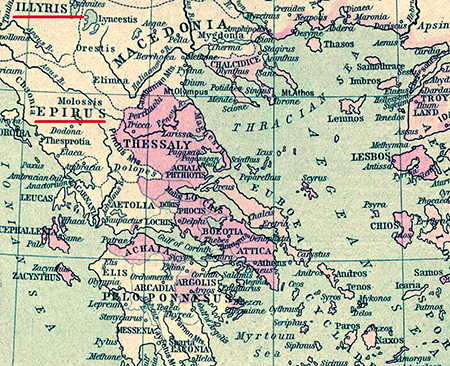
Illyria and Epirus,
Ancient Greece
Click map to enlarge.
Hence the words Greek,
Hellenic, and Grecian are used interchangeably.
Ancient Greek Towns
Just as anywhere in the world, towns and states in ancient Greece
joined forces in various alliances to be better protected against their
enemies.
There were the
 amphictyonies, which were
religiously motivated coalitions. Such were the
amphictyonies, which were
religiously motivated coalitions. Such were the
 Delian Amphictyony and the
Delian Amphictyony and the
 Delphic Amphictyony.
Delphic Amphictyony.
And then there were the politically
motivated coalitions, such as the
 Achaean League, and the
Achaean League, and the
 Aetolian League.
Aetolian League.
See also
 Forms of Goverments.
Forms of Goverments.
Ancient Greek Rulers
See
 Governments of Greece.
Governments of Greece.
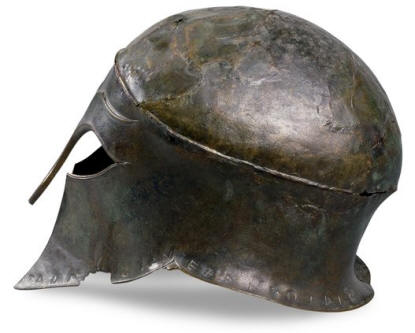
Bronze Helmet from
Ancient Greece, around 460 BC
The British Museum, London
Wars and Battles in Ancient Greece
The Trojan War
The Greeks fought against Troy in the Trojan War 1185-1175 BC. This
war is fiction but there might be some actual events mixed up in its
tale.
The entire conflict was provoked by
Paris, who was the son of
Priam, the king of Troy. When
Paris met Helen (female) who was married
to Menelaus, the king of Sparta,
he decided to keep her. All hell broke loose and Troy was eventually
sacked by the Greeks.
See also
 About Troy
About Troy
The Messenian Wars
The Messenian Wars were fought between Sparta (conqueror) and
Messenia (the conquered.)
First Messenian War
fought around 735-715 BC
Second
Messenian War
fought around 660 BC
Third Messenian War
fought around 464 BC
(also called the Messenian Revolt)

Messenia and Sparta, Ancient Greece
Click map to enlarge.
More under
 Helots
Helots
The Lelantine War
Chalcis and Eretria, two powerful ancient Greek cities on Euboea,
fought each other in the
Lelantine War. The war was
fought from around 720 to 680 BC. The objective was control over
the Lelantine Plain, which was the fertile plain that separated the
two contestants. Chalcis won but lost its king.
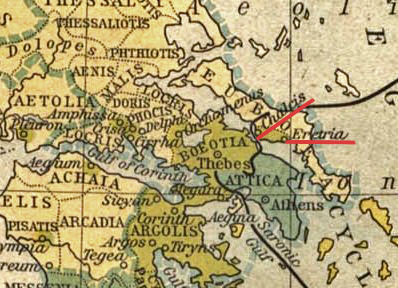
Chalcis and Eretria on Euboea, Ancient Greece
Click map to enlarge.
The Sacred Wars
The ancient town of Delphi
was located right next to Mount Parnassus. The town's most famous
citizen was a lady in her 50s, who worked full-time as an oracle in
the local temple of Apollo. Apollo himself gave her messages.
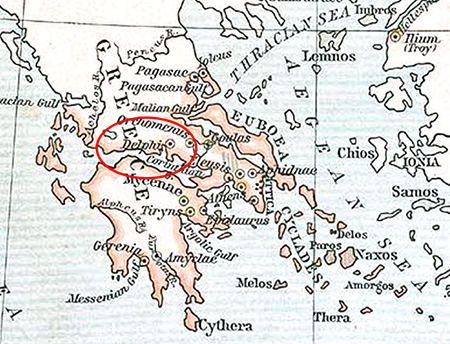
Map Location of
Delphi, Ancient Greece
Click map to enlarge.
The Oracle of Delphi furnished the regional department of tourism
with a healthy buck, but it also enticed the Greeks to fight each
other over possession of the sanctuary. These were the
Sacred Wars.
First Sacred
War
fought around 596-590 BC
Second Sacred
War
fought around 449-448 BC
Third Sacred
War
fought around 355-346 BC
(Some call this war the Second Sacred
War)
Fourth Sacred
War
fought around 339-338 BC
Read
 what the Delphic Oracle
had to say about Alexander the Great.
what the Delphic Oracle
had to say about Alexander the Great.
The Persian Wars
Of major
concern were the Persians, who challenged the ancient Greeks
frequently, repeatedly invaded the country, and tried to make it
part of their realm. The Greeks were against this general idea and fought
back, first in the
 Ionian Revolt
from 499-494 BC, and then from
492-449 BC, in the Ionian Revolt
from 499-494 BC, and then from
492-449 BC, in the
 Greco-Persian Wars, also called the
Persian Wars. Greco-Persian Wars, also called the
Persian Wars.
The Peloponnesian Wars
The ancient
Greeks fought each other again in the First
Peloponnesian War from 460 until 445 BC, and then in the
 Second Peloponnesian War from
431-404 BC.
Second Peloponnesian War from
431-404 BC.
Athens fought against its former ally Sparta.
These were the principal belligerents, but
everybody was dragged into it.
The Corinthian War
Athens,
Corinth, and others fought once more against Sparta from 395-386 BC.
This was the Corinthian War.
Go here for a
 chronological index of all wars.
chronological index of all wars.
 |
Constitutional and Judicial Law in Ancient
Greece
Lycurgus,
also spelled Lykourgus, might or might not have existed. If
he did, he lived around the 7th century BC.
 Herodotus,
Herodotus,
 Xenophon, and
Xenophon, and
 Plutarch
tell us that he did, and that's good enough for us. Plutarch
tell us that he did, and that's good enough for us.
Tradition has it that Lycurgus
dramatically improved the law of ancient Sparta.
|
Draco,
also a figure from the 7th century BC, was responsible for the 621
BC Draconian Laws in Athens.
Draco liked to keep things simple and prescribed the death penalty
for pretty much any criminal offense.
Solon,
who lived 630-560 BC, was the man who revised Draco's law code and
made it a bit more humane. His was the set of reforms known
as Solon's Laws.
Cleisthenes, also spelled Clisthenes or
Kleisthenes, who lived 570-508 BC, brought democratic
reforms into effect in Athens.
 Pericles, who lived
495-429 BC, was a powerful democrat in Athens. He initiated laws
that granted Athenian citizenship only to individuals whose parents
were both Athenians. It was also Pericles who was behind the great
Pericles, who lived
495-429 BC, was a powerful democrat in Athens. He initiated laws
that granted Athenian citizenship only to individuals whose parents
were both Athenians. It was also Pericles who was behind the great
 construction project on the Acropolis.
Plus, the man could
construction project on the Acropolis.
Plus, the man could
 deliver a solid speech.
deliver a solid speech.
Pericles was good for the patriotic
soul at Athens, especially after the Persians had destroyed nearly everything on the Acropolis and
downtown in 480 BC.
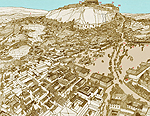
Ancient Athens - Points of Interest
 Demosthenes, 384-322
BC, was an outstanding politician and orator. Not many could
match his wit.
Demosthenes, 384-322
BC, was an outstanding politician and orator. Not many could
match his wit.
Archaeology of Democracy
Here is a wee piece from History
International:
"Below are the
remains of the Athenian House of
Representatives, where 500 Athenian senators
once voted on legislation.
"And it was here where the first jury system
was conceived."

Remains of the
Athenian House of Representatives
History International
"Instead of 9
men and women it was a jury of 201, or 501,
of 1501 Athenian citizens who happened to be
sitting on the jury on that day, who would
make essentially the constitutional
decision.
"They would
have jurors tickets, and they would be
assigned by lot. You couldn't tell until the
court actually began sitting who was going
to be a juror that day. So it was very hard
to bribe an Athenian jury.
"Archaeologists have uncovered the stone
ballot box and dozens of bronze ballots that
were used to vote for either sentence
or set free a defendant."

Stone Ballot
Box
History International
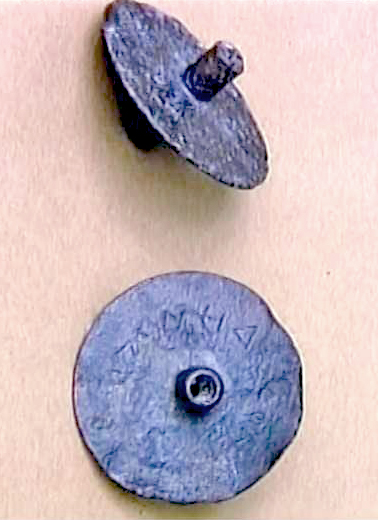
Bronze Ballots
History International
See also
 Forms of Governments.
Forms of Governments.
Ancient Greek Culture, Art & Entertainment

Ruins of an Ancient Greco-Roman Theater at
Tauromenium, Sicily
This theater seats up to 11,000 people.
Find this photograph and much more in the incredible
Ancient Theater Archive.
 Homer, probably the man who
brought you the Iliad and the Odyssey, lived sometime before 700 BC.
Homer, probably the man who
brought you the Iliad and the Odyssey, lived sometime before 700 BC.
 Hesiod was a Greek poet, who
lived around 700 BC.
Hesiod was a Greek poet, who
lived around 700 BC.
Alcman,
also spelled Alcmaeon, was a poet
from Sparta, which was the rare animal
because Sparta prided herself in looking
down on the arts. The average Spartan loved
order and discipline, and had nothing but a rug
beater hanging on the wall.
Sappho
hailed from Lesbos and was a famous poet. She lived around 610-570
BC, back in the days when lesbians were usually married to men in
spite of it, but no closets existed.
 Aeschylus, who lived 525-455
BC, was the man who
changed the theater experience for the ancient Greeks. You want
ancient Hollywood, you want Aeschylus.
Aeschylus, who lived 525-455
BC, was the man who
changed the theater experience for the ancient Greeks. You want
ancient Hollywood, you want Aeschylus.
Pindar,
also spelled Pindaros, came from Boeotia. He lived 518-446 BC
and was an outstanding poet and probably equally brilliant as a composer. The
Pindaric Ode is named after him.
Polyclitus
sculpted away during the mid-400s BC. He knew all about the perfect
proportions of the human body.
Sophocles,
496-406 BC, was a prolific playwright. As was
Euripides, 484-406 BC.
A playwright,
Aristophanes' (450-388 BC) forte was the ancient Greek
comedy.
Praxiteles
was a celebrated sculptor and lived somewhere around 370-330 BC.
Menander,
342-292 BC, was the top playwright during the last phase of the
comedy in ancient Greece.
Chares of
Lindos, not Charles A. Lindbergh, was the artist and
sculptor responsible for the
Colossus of Rhodes, one of the
 7 Wonders of the World. Chares
and his team worked on the good piece from 294-282 BC. The statue
presented the god Helios and stood 105 feet or 32 meters high. It
took an earthquake to bring it to its knees and many Arabian camels
to steal all the bronze.
7 Wonders of the World. Chares
and his team worked on the good piece from 294-282 BC. The statue
presented the god Helios and stood 105 feet or 32 meters high. It
took an earthquake to bring it to its knees and many Arabian camels
to steal all the bronze.
Famous Architecture in Ancient Greece
The hill at the center of Athens is
called the Acropolis. The word acropolis stems from the Greek
word akros, meaning high or upper, and the
Greek word polis, meaning city. Thus, acropolis means
high city or city at the top, and can refer to any
important citadel in ancient Greece.
The Acropolis at Athens, of
course, became the most famous. Here is the map:

Athens AD 200
The four surviving structures on the
Acropolis are
-
the
Propylaea, which is the entrance to the
Acropolis
-
the
Parthenon (temple)
-
the
Erechtheum (temple,) and
-
the
Temple
of Athena Nike.

AD 200 Acropolis
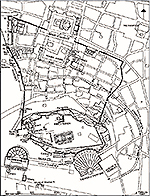
Ancient Athens -
Downtown
Construction commenced
in 447 BC:
The
Parthenon was the
temple to visit. It is located on the Acropolis of Athens. All the worship in the Parthenon went
to the goddess Athena. What's with the name? Parth�na means
virgin.
Therefore...
Athena Parthenos = Athena
the Virgin.
The Parthenon is good for you because
it keeps you on your toes. How so? It was built in the
Doric style but includes Ionic style features.
See more under
 Panathenaic
Festival. Panathenaic
Festival.

Parthenon, Acropolis,
Athens, Greece
Encyclop�dia Britannica
Another photograph of the Parthenon:

Parthenon, Acropolis,
Athens, Greece
The Archaeology of Athens, Yale
University Press
The decline of the Parthenon was highlighted by the following
events:
In the 5th century AD, Christians
began using it as a church. In 1458, the Turks took over, and from
1460, they used it as a mosque and a powder magazine. In 1687, the
Venetians, who had a beef with the Turks, bombed the Parthenon, and
the entire building was catapulted to the moon.
Construction commenced
in 421 BC:
The
Erechtheum was another temple built on the Acropolis, and
we are talking Ionic style. According to Homer's Iliad,
Erechtheus was a major player, raised by Athena herself. And this is
his temple.
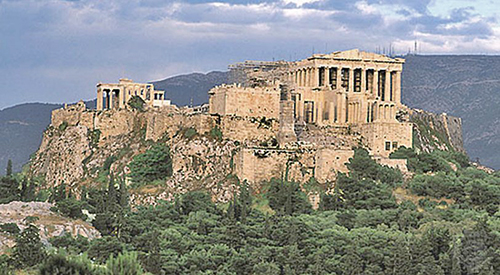
The Acropolis at
Athens: Parthenon to the Right, Erechtheum to the Left
AISA, Archivo Iconogr�fico,
Barcelona, Espa�a
The Erechtheum was considered a jewel
of architecture. Outside this temple an oil lamp burnt day and
night. Inside, devotees found shrines to many gods as well as the
most important image of Athena on the Acropolis. This was a very
ancient wooden image that the ancient Greeks believed had fallen
from the sky. In front of the temple's entrance was an altar to the
god Zeus.
Here is a fantastic shot of the Erechtheum:

The Erechtheum in
Athens, Greece
LevineDS, Wiki
And we're zooming in on the figures on the south side:

Porch of the
Maidens, South Side of the Erechtheum, Acropolis, Athens
Stuart Lees
And further zooming in on the gals:
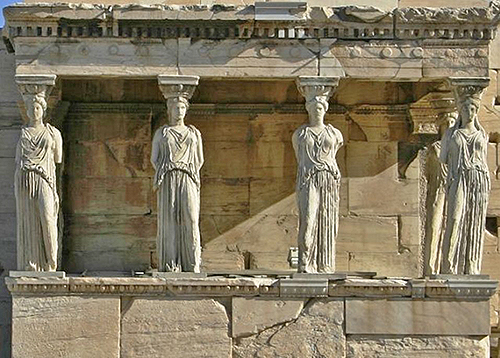
Porch of the
Maidens
Diane Earl
Who were these women?
Some believe they symbolize maidens
that had been captured in battle. Others believe that these women
were the daughters of the legendary king
Cecrops, whose grave was rumored to be located right
underneath this temple.
By the way...
When you see a lady carrying part of a building, chances are that
you are looking at a caryatid.
Therefore, the above picture shows the Porch of the Caryatids. If
they were male, they would be the atlantes. One
atlas, two atlantes.
Back to the building projects in
ancient Greece.
Piraeus
Another huge construction site was
Piraeus, the harbor of Athens,
located 4 miles or 6 kilometers southwest of Athens.
Around 510 BC,
 Hippias built a fortress on the
Munychia hill, overlooking and protecting the port.
Hippias built a fortress on the
Munychia hill, overlooking and protecting the port.
Around 492 BC,
 Themistocles advised on the
importance of a fortified port for Athens. Around 460 BC, the
so-called Long Walls were built,
which connected Athens and Piraeus and would come in handy when
under siege.
Themistocles advised on the
importance of a fortified port for Athens. Around 460 BC, the
so-called Long Walls were built,
which connected Athens and Piraeus and would come in handy when
under siege.
Designer of the city of Piraeus was
Hippodamus of Miletus, who had
his architectural plans on the desk and ready by 450 BC.
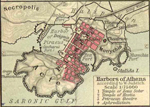
480 BC
Harbors of Athens

Athens and Piraeus from 460 BC
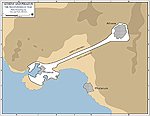
Athens and Piraeus 431
BC
Religion Ancient Greece Style
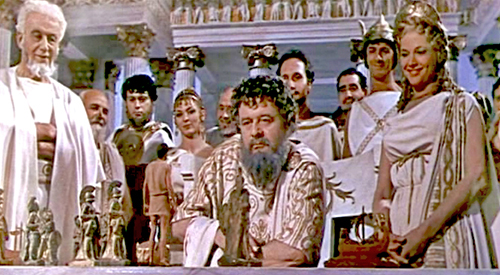
Zeus (Niall MacGinnis,
center) and Hera (Honor Blackman, right)
... entertain themselves and
their colleagues at Mount Olympus, in the 1963 version of
Jason and the Argonauts. And yes, Hera was the Bond girl in
Goldfinger, 1964.
In the beginning....
There was
Uranus (Heaven) and Gaea
(Earth) and these two had 12 children, aka the
Titans.
These lovely kids were (boys first)
Oceanus, Coeus, Crius, Hyperion, Iapetus, and Cronus and (now the
girls) Thea, Rhea, Themis, Mnemosyne, Phoebe, and Tethys.
Cronus led his siblings in a revolt
against their father and succeeded.
Now...
Cronus had several children. One of
them, Zeus, turned out to be a
fast learner. Zeus also led his siblings in a revolt against their
father, Cronus, as well as against all other Titans. Zeus won after a
hard fight and was able to defend his position
against all rivals.
Thus, Zeus
became chief god of the ancient Greeks. His favorite weapon was the
thunderbolt. Zeus' wife was Hera,
the daughter of Cronus and Rhea.
Home of the gods was Mount Olympus.
Zeus had many love affairs, but his
daughter, Athena, he fathered
all by himself. Athena, also spelled Athene, simply popped
from his forehead. Athena was the goddess of war and the secret
fantasy of all women in labor.
Together with
Leto, who was the daughter of Coeus and Phoebe, Zeus had twins — Apollo
and Artemis.
According to the ancient Greeks, the
goddess Athena and her uncle Poseidon, god of the sea and brother of
Zeus, competed to rule over Athens. Athena gave the city the olive
tree. Poseidon struck his trident on the lime stone of the Acropolis
and produced a spring of salt water. The people of Athens voted the
olive tree more useful than the salt water spring and declared
Athena winner of the contest. Hence, Athena became divine guardian
of the city.
Go here to check the
 Divine Almanac.
Divine Almanac.
The Language in Ancient Greece
Greek is the oldest of the
Indo-European languages. Several dialects existed. The
Ionic dialect, for example, was
spoken on the island of Euboea. As Greek influence grew, the dialect
spoken at Athens, the
Attic dialect, prevailed. In its
later phase, from the 4th century BC, it was called
Koine.
In the 3rd century BC, the Old
Testament was translated from Hebrew into Koine. This bible
translation is called the Septuagint.
Koine eventually grew into Modern
Greek.
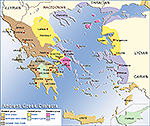
Map of the Ancient Greek Dialects
See also
 The History of Languages - Language Roots
The History of Languages - Language Roots
And here are the
 Greek Numerals.
Greek Numerals.
Ancient Greece, Homosexuality, and Nudity
Homosexuality, especially
between males, was common and tolerated in ancient Greek society.
This continued during the times of the ancient Romans until the
spread of Judaism, Christianity, and Islam, which declared it insupportable.
The ancient Greeks found nothing
scandalous about nudity. Athletes at the Olympic Games, for example,
competed in the nudes.
Science and Philosophy in Ancient Greece
Thales,
a chap from Miletus, lived somewhere during the 6th century BC.
Not only did the man predict a solar
eclipse in either 610 or 585 BC, he also had a rectangle. Here
it is:

Thales' Rectangle
Encyclop�dia Britannica
Geometricians will tell you what exactly to do with it and how
somehow the halves of the diagonals in a rectangle all
have the same length.
Today, Thales' home-town Miletus is a suburb of S�ke in
Turkey. Here is the map:
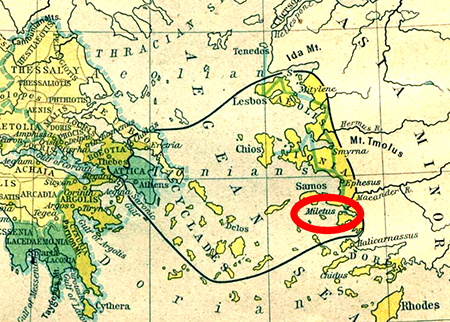
Map Location of Miletus
Click map to enlarge.
Also from Miletus, from around the same time, and well acquainted with
Thales, was Anaximander.
Although not very accurate with his philosophy and astronomy,
Anaximander at least tried to explain life, universe, and
everything. Points for effort.
 Pythagoras of Samos, favorite
of many a math student, had an exceptional brain. He was also the founder of something close to a
religion. It was called
Pythagoras of Samos, favorite
of many a math student, had an exceptional brain. He was also the founder of something close to a
religion. It was called
 Pythagoreanism. Pythagoras lived
580-500 BC and started his own university in 532 or 530 BC at Croton,
today's Crotone, Italy. His theorem had hypotenuses. Pythagoreanism. Pythagoras lived
580-500 BC and started his own university in 532 or 530 BC at Croton,
today's Crotone, Italy. His theorem had hypotenuses.
Empedocles,
490-430 BC, was a mixture of politician, poet, and philosopher. He
pointed out that the main elements of everything are fire, air,
water, and earth.
Top philosopher
 Socrates lived 470-399 BC and
made headlines when he was put on trial at age 70. He received the
death penalty.
Socrates lived 470-399 BC and
made headlines when he was put on trial at age 70. He received the
death penalty.
Socrates had a bright pupil, the
future philosopher
 Plato, 428-347 BC.
Plato, 428-347 BC.
Plato, in turn, also had a bright
pupil, the future philosopher
 Aristotle, 384-322 BC.
Aristotle, 384-322 BC.
But Aristotle's pupil was the one who
blew everyone else out of the water. From age 13 to 16, the young boy
 Alexander
of Macedonia was under Aristotle's wings. Alexander
of Macedonia was under Aristotle's wings.
 Xenophon, 430-350 BC, was a
philosopher as well as a historian.
Xenophon, 430-350 BC, was a
philosopher as well as a historian.
And much to the delight of astrophysicist Neil deGrasse Tyson, Aristarchus of Samos,
who lived 310-230 BC, was of the opinion that the Earth rotated on its axis and revolved around the sun.
Archimedes, who lived 290-211 BC, was impressed by
Aristarchus' ideas. But being the brilliant inventor and
mathematician that he was, Archimedes had much to
contribute himself, for example Archimedes' principle.
Buoyancy is the power of floating, and Archimedes had it figured
out.
Sports in
Ancient Greece

Discobolus,
aka the Discus Thrower, by Myron
This is a Roman marble copy of
Myron's original from the 5th century BC in bronze. Some goof-ball
multi-tasked when he restored this statue. The head should be facing
the discus.
The British Museum, London
Ancient Greece had several athletic events, for example the Pythian
Games, the Isthmian Games, and the Nemean Games. The most ancient and
most famous of them, the Olympic Games,
commenced in 776 BC, maybe even earlier.
All of course thanks to Zeus, the
Greek's main god, which is the reason why one of the
 Seven
Wonders of the World, a 40 feet or 12 meter statue of
Zeus, was erected in Olympia around 430 BC. Seven
Wonders of the World, a 40 feet or 12 meter statue of
Zeus, was erected in Olympia around 430 BC.
The statue showed Zeus on a throne and
was decorated with ebony, ivory, gold, and all kinds of precious
stones. The ancient artist behind this masterpiece was the
Greek sculptor Phidias, who
had it made.
Already in 438 BC, Phidias had created
another statue of this height showing Athena standing and with a
spear in her hand. It was on display at the Parthenon.

Ancient Olympia
Back to the 776 BC Olympics.
The champion's name was
Coroebus of Elis. He won the
stadion race, (stadion = track for footraces) which was the only discipline for the first 13
recorded Olympic Games, starting in 776 BC and held every four
years in August/September.
And there was no lady folk at the
Olympics, not competing, not in the audience. The women were banned
from Olympia during the games. So tells us ancient travel writer
Pausanias in the 2nd century AD.
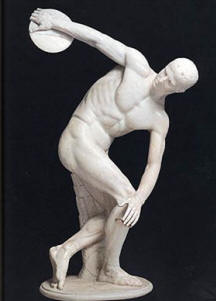
Myron's Discus
Thrower With Correct Head
PalaMazzola, Taranto
The modern
Olympic Games started in 1896 in Athens (Summer Games.) No female
athletes.
The Winter
Games came in 1924. Chamonix in France was the first host. Only 11
women competed at Chamonix, by the way. All in figure skating, the
only discipline open for female athletes.
For the marathon race, see more at
 The Legend of Marathon
The Legend of Marathon
And speaking about events...
The
Panathenaic Festival,
also called the Panathenaea, Panathenaia, or the
Great Panathenaea, was the party for the people of Athens. This
event was founded by Theseus and
commenced in 566 BC.
It was originally held annually on the
28th of Hekatombaion (July/August), which was Athena's birthday, but
then every four years because the Olympic Games had the same
routine and much success with this schedule.
At the Panathenaics, the people
celebrated Athens, the goddess Athena, and themselves. To this end
they sacrificed a large amount of animals, held a grand procession, listened to
fantastic live music contests, poem contests, and watched athletes
compete.
The chariot races were one of the
highlights, the kicker being that the race drivers had to jump out
of their chariot and run through the finish line on foot. Much
excitement there. All in honor of the gods, and the winner went home
with a jar of olive oil.
The entire momentum of the festival was captured,
chiseled, and sculptured onto the fringe of the
 Parthenon,
now known as the Parthenon Frieze,
all in all 160 meters or 525 feet long. The length of this artifact
was good news for all major museums because they almost each could
get a piece. Parthenon,
now known as the Parthenon Frieze,
all in all 160 meters or 525 feet long. The length of this artifact
was good news for all major museums because they almost each could
get a piece.
Here is the bit that you can examine
when you visit the Acropolis Museum in Athens:

View of the West and
South Frieze of the Parthenon
The Parthenon Gallery
This is the link of your choice should you opt to
 check out the frieze in detail.
check out the frieze in detail.
See also
 What are the Elgin Marbles?
(Article by the British Museum)
What are the Elgin Marbles?
(Article by the British Museum)
Did the Ancient Greeks Sacrifice Humans?
It is disputed whether one scene on the frieze of the Parthenon
depicts three virgin women who were offered as a sacrifice to the
gods to save Athens.
"Human sacrifice in ancient Greece was
definitely carried out in the historical
period. It seems to have been used only in
times of dire necessity, when there was for
example a plague, a famine, or a military
problem and you needed to propitiate the
gods to end this terrible misfortune."
Prof. John M.
Camp II, director of the Agora excavations
of the American School of Classical Studies
at Athens and professor of classics at
Randolph-Macon College, VA
However, human sacrifice had been discontinued by the Golden Age,
which began around 480 BC.
More Maps of Ancient Greece
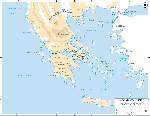
Ancient Greece

Ancient Crete
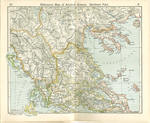
Ancient
Greece (north)
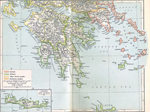
Ancient
Greece (south)

700 - 600 BC
Greece

550
BC Mediterranean Sea

500 - 479 BC
Greece
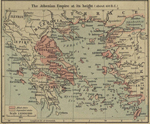
450 BC Greece
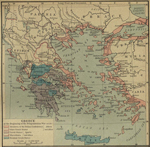
431 BC Greece

362 BC Greece
More History
|